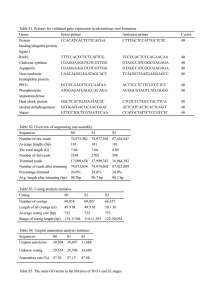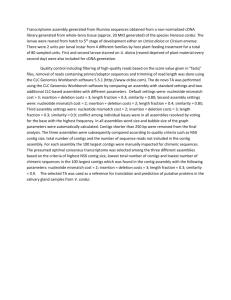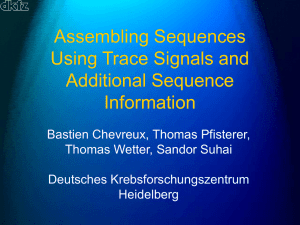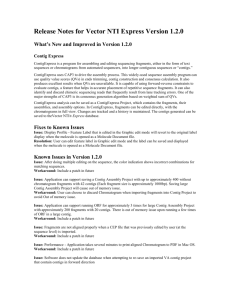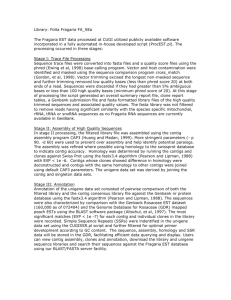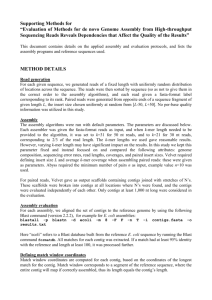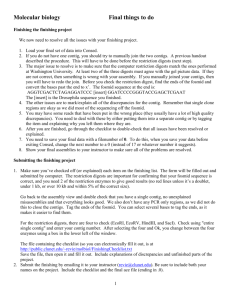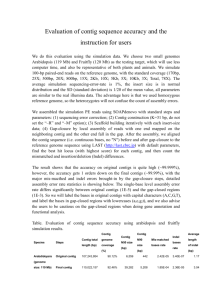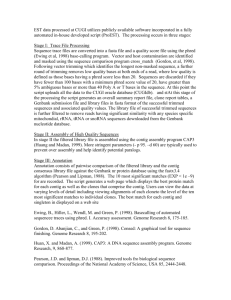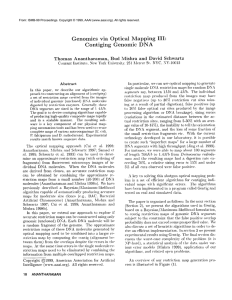18.417 Introduction to Computational Molecular ... Problem Set 3 Issued: October 5, 2004 Lecturer: Ross Lippert
advertisement
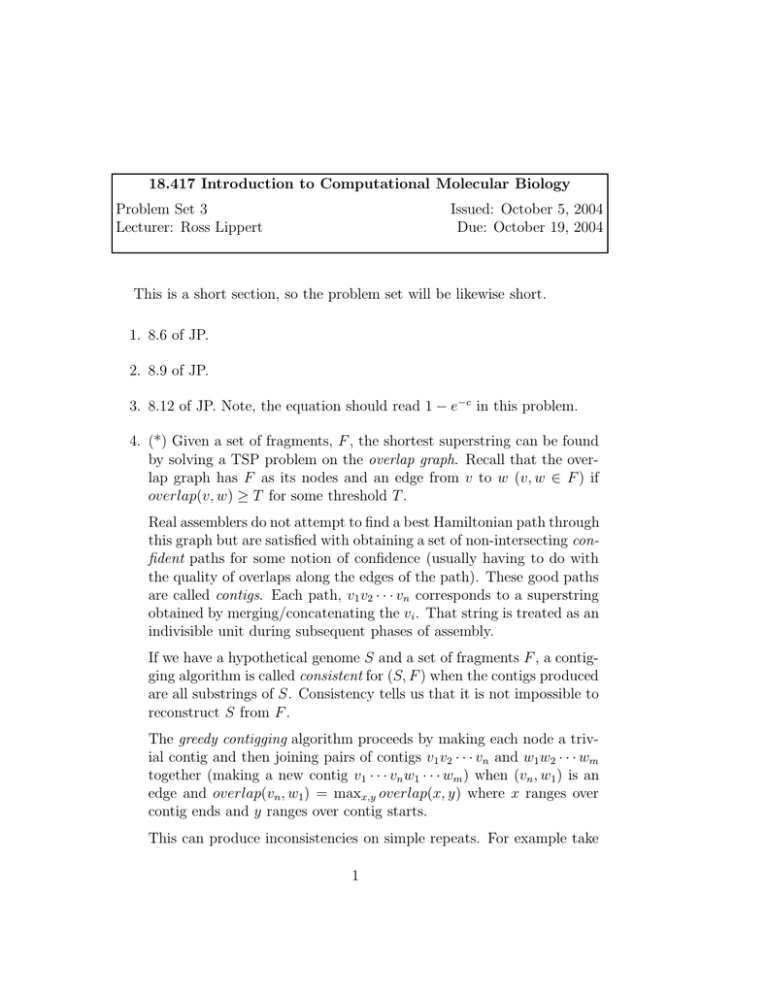
18.417 Introduction to Computational Molecular Biology
Problem Set 3
Lecturer: Ross Lippert
Issued: October 5, 2004
Due: October 19, 2004
This is a short section, so the problem set will be likewise short.
1. 8.6 of JP.
2. 8.9 of JP.
3. 8.12 of JP. Note, the equation should read 1 − e−c in this problem.
4. (*) Given a set of fragments, F , the shortest superstring can be found
by solving a TSP problem on the overlap graph. Recall that the over­
lap graph has F as its nodes and an edge from v to w (v, w � F ) if
overlap(v, w) � T for some threshold T .
Real assemblers do not attempt to find a best Hamiltonian path through
this graph but are satisfied with obtaining a set of non-intersecting con­
fident paths for some notion of confidence (usually having to do with
the quality of overlaps along the edges of the path). These good paths
are called contigs. Each path, v1 v2 · · · vn corresponds to a superstring
obtained by merging/concatenating the vi . That string is treated as an
indivisible unit during subsequent phases of assembly.
If we have a hypothetical genome S and a set of fragments F , a contig­
ging algorithm is called consistent for (S, F ) when the contigs produced
are all substrings of S. Consistency tells us that it is not impossible to
reconstruct S from F .
The greedy contigging algorithm proceeds by making each node a triv­
ial contig and then joining pairs of contigs v1 v2 · · · vn and w1 w2 · · · wm
together (making a new contig v1 · · · vn w1 · · · wm ) when (vn , w1 ) is an
edge and overlap(vn , w1 ) = maxx,y overlap(x, y) where x ranges over
contig ends and y ranges over contig starts.
This can produce inconsistencies on simple repeats. For example take
1
2
Problem Set 3: 18.417
T = 2 and
f1
f2
f3
f4
f5
S
t a c a t
c a t g
t a c a t g
g
g
g
c
c t t g
t t g
c t t g
a c
a c a t c
a c a t c
and greedy contigging produces f1 f5 � tacatc and f2 f3 f4 � catggcttgac.
We see that even though the S can be assembled from a contig of the
overlap graph the contigs which are produced are inconsistent with S,
meaning S cannot result from any subsequent assembly steps.
The Celera assembler used a more conservative algorithm. Given a con­
tig v1 · · · vn a best-suffix is the contig w1 · · · wm such that overlap(vn , w1 ) =
maxx overlap(vn , x) and a best-prefix is the contig such that overlap(wm , v1 ) =
maxy overlap(y, v1 ), where x ranges over contig ends and y ranges over
contig starts. We merge contigs A and B into the contig AB if and
only if A is the only contig who has B for a best-suffix and B is the
only contig having A as a best-prefix. This was called the thickest edge
rule, though that is probably a misleading name.
For the example above, this is consistent: we do not merge F1 and F5
because F1 is a best prefix of both F2 and F5 . However, this algorithm is
not consistent for every (S, F ). Produce an example where the thickest
edge rule will give inconsistent contigs, but where there exists a contig
f1 f2 · · · fk in the overlap graph whose superstring is S.1
5. 8.20 of JP. To clarify this problem: given a peptide, you have a set
of theoretical masses which come from al the N-terminal prefixes and
the C-terminal suffixes. If a mass modification happens at amino acid
i, all prefixes after i and suffixes before i are modified likewise. Thus
the problem is one of “Allowing k arbitrary mass modifications to the
amino acids of the input peptide, find the highest shared peak count
between the mass spectrum of the modified peptide and some arbitrary
input mass spectrum (about which you know nothing).
1
It is very possible that I have mis-written some part of this problem. If clarifications
need to be made, I’d rather not make them the night before the problem set is due.
Problem Set 3: 18.417
3
6. (*) 8.26 of JP. “Efficient” here means O(nd ) for a smallish d. Don’t
reduce it to a “find a Hamiltonian path problem” and think that will
do.
7. This is a simplification of the problem of identifying a substring of a
large database like SwissProt or NRAA (tens of millions of amino acids
long) that matches the mass of some peptide (5-30 amino acids long).
n can be 108 , N will be in the hundreds or thousands, while the mi ’s
are from 500 to 50k (that is beyond the upper limit of reliable mass
measurement on a mass spec instrument).
Devise an O(n) algorithm which will locate all substrings of mass m
in a string S (of length n) of amino acid sequences given a table of
amino acid weights (positive integers). Extend this algorithm to allow
the location of N masses {m1 , m2 , . . . , mN } in S in time faster than
O(N n + X), where X is the number of actual matches (that is, it
should perform better than O(Nn) when X is small but no worse that
O(X) when X is large).
